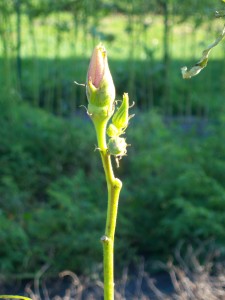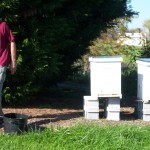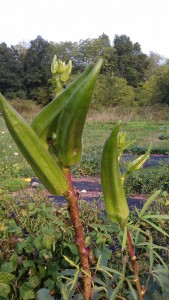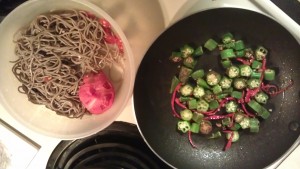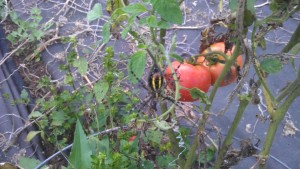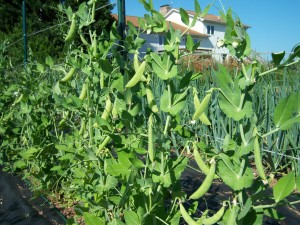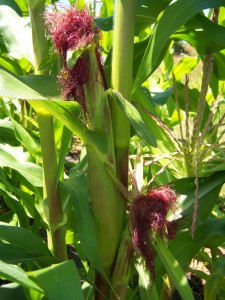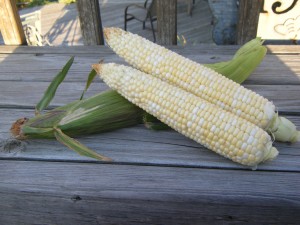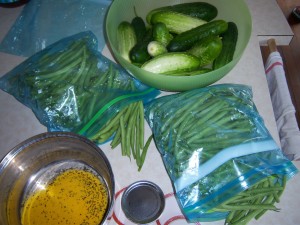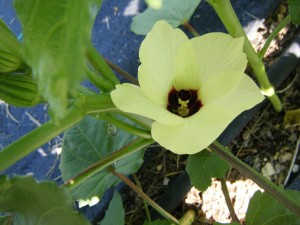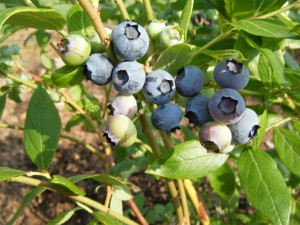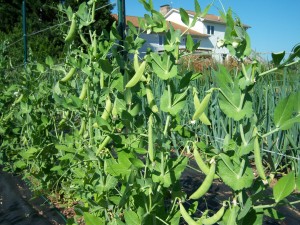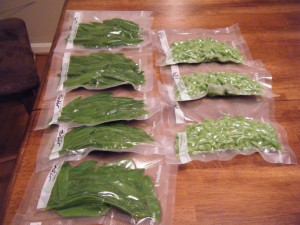Garden
Honey supers
0Garden
It was a rainy weekend, but toward the end we got a little sun. That was enough. I have been dismayed that I haven’t gotten any of our spring planting done. We have stuff to plant now, but I just haven’t had the chance to get it into the dirt. So when the sun peeked out, I grabbed my gloves and trowel and headed for the little raised bed garden. I planted two small rows of beets , two rows of radishes, a few red onions, and six small lettuce plants. I still have lettuce and spinach seeds to sew and more onion sets to plant as well as a few broccoli and brussel sprout plants.
It’s not much, but at least it’s a start. I still need to rig up the pea trellis.
Bees
The other exciting news is that I did a quick inspection of my two older hives to see how full the upper boxes were. Assuming that there was still room, I would feed again and decide when to put on the honey supers (the boxes on top of the brood boxes used exclusively to store honey). What I found was that the top brood boxes were almost completely full. I only pulled out the outer frame and found comb half filled with nectar even on the outside of the frame, which is typically the last place the bees go looking for space. So I quickly ran to grab the supers and queen excluders to install them.
My fear is that I am too late. I understand that if the workers have already decided that it is too crowded and have started the process of raising a new queen in preparation for supersedure, then there is no stopping it and they will swarm. I might want to check the bottom box for queen cells in a week or so, to find out. If queen cells are present (perhaps 5 to 10 of them), then they will almost certainly swarm and my only recourse is to watch for it and try to capture the swarm and reinstall them into another hive. I’m not really prepared for that. I would need to prepare a new box and some frames. I really hope they don’t swarm, because I could easily miss then and lose half my bees. Even if I were to capture them, I would have two hives at ‘half power’ and might not get much honey from the old one (and none from the new one).
So I will hope they don’t swarm and that the weather stays nice and that there are adequate nectar sources now. If all that happens, then they will start to build comb in the honey supers and then store nectar and make honey. Can you tell I am excited.

Farm in November
0Garden
As the weather has been wet and cool, growth in the garden has slowed to a crawl. Surprisingly, the okra continues to make new flowers and fruits. The okra has been such a great crop. We will definitely grow some next season. The cherry tomatoes finally made their comeback after the rain stopped and we got some sun. I have been able to pick as many to eat as I want, which is how most of them are consumed. I sometimes bring a bowl full into the house, but they never seem as good as when I pick them right off the plants. The peppers are perhaps the most durable and fruitful of all the late garden plants. We always have lots of peppers left when the first frost arrives – which it did just a few days ago. Sadly, it was a pretty good freeze – at least five degrees below freezing – and all the plants took it pretty hard. To make matters worse the freeze has continued for four or five nights straight. Any chance that a slightly protected plant might have survived is now gone. All the tomatoes are mush as are all the peppers. I picked just a few tomatoes and peppers to bring in, blanch, peel, and put in a big pot of chili. The was the End-Of-The-Garden Memorial Chili Dinner. I think it should be the start of a new tradition.
Honeybees
The bees better be preparing for winter. I keep feeding them, but I don’t really want to open up the hives to see what is happening in there. I fear that the disruption in honey production might be worse than my fears of not knowing. Next year I will definitely do a few things differently. I really like the idea of getting some kind of relative weight throughout the season. I think I will take the advice of one of the bee club members and put a scale under the back edge of the hive every time I go out to look or feed and record that. I’m not sure what conclusions I will be able to draw, but I will at least have some data to work with.After the past several nights of freezing weather, the bees still are very active on a day like this where it is around 60 degrees and sunny. I have seen them on my mums and they are still bringing in pollen. I really don’t understand what happens to the population around this time of year. I suppose it decreases as they make room for more honey then brood. I need to get back to the books and remind myself that I still have a lot to learn.
Chickens
We finally got the palace chicken yard fenced in, but still need to build the gate. That’s what I should be doing today while it is so nice. They are making the most of the yard now and it looks like it could use some time off. I didn’t think that the 21 birds would eat down the grass so much, but they have and it needs a break. I guess this means that I will need to fence in the alternate yard early next spring. It was always the plan to have two separate areas that we could release the chickens into. The fencing project was more expensive than I had thought, but it really is a lot nicer than the fencing around the original coop. So if we can fence in a second area (to the south and west of the palace), it should really help the grass recover. Maybe we can move them every couple of weeks.
The Ameraucanas who laid a couple of eggs early and then stopped for a month, finally started to lay again and have been quite regular now. They are also bigger eggs than most of the light brown layers. I was hoping that by now all the eggs would be full sized, but I don’t think they are. Hopefully when they get rolling in the spring, they will be fully mature. I have been trading eggs for baked good with some of my yoga students and have sold a few dozen, but we will need a bunch of regular customers to keep up with all the eggs in the spring. And, of course, I want some more chickens next year, too. We will try to mate the Marans to get some more chocolate eggs, but will need to buy a few more Ameraucanas as we are lacking a rooster. Our two new roosters, Duran and Big Red have come to accept each other with no show of fighting. Early on Duran was clearly the boss, but more recently if either of them mounts a hen, the other will run over to ‘assist’ or at least encourage the act. I never imagined this kind of cooperation among the roosters.In the old coop, Percy is finishing his molt and might be getting his mojo back. Since the molting started, Tarick the younger, smaller rooster has been terrorizing Percy. Percy has been the clear boss up until this molt, but Tarick has been making up for lost time. We have had to protect Percy by putting him in the nursery coop out of Tarick’s reach. Before doing that poor Percy was hiding in the nest boxes – very unrooster-like. But finally Percy is beginning to show signs of being frisky again when we step into the nursery coop to supply food and water. I almost forgot to mention that Percy also had a broken spur. We discovered it one day because his foot was bloody. It seems as though the spur sloughed off of the bone. I didn’t realize this but I guess the spur is kind of a covering on a much smaller bone. I don’t know if this broken spur is related to the molt or not, but the combination sure seems to have taken all the aggression out of Percy. Joni did a great job of cleaning and bandaging his leg to protect the spur bone for several days and it looks to be healing well. It will be interesting to see if Percy can regain his stature as head rooster or if his reign is over.

Garden update
1The garden is different every year. It is planted with different crops in different rows and the size has increased somewhat each year. I am already thinking about where the expansion will take place next spring. But it always surprises me in some way. This year we planted a few new things including corn and okra. The corn was a minor disappointment (bugs got more corn than we did), but the okra was a real winner. We planted two varieties and I think one did better than the other, but both are still producing. I even planted a second half-row which is only now starting to flower and bear fruit. It looks terrific. Now this might not be as exciting if you don’t like okra, but I do and I am very pleased with the results. I have been eating a lot of it mostly broiled. With the new crop coming in, I hope I can get some in the freezer.
Another new crop this year was edamame. This is just a variety of soybean. I have never grown regular soybeans, so I really don’t know what the difference is. They have taken a long time to mature and are now just about right to start picking. They were planted a few weeks after the squash and about the same time as some as some other beans. The beans and squash are pretty much done producing, but the edamame is just beginning.
It seems like peppers always have a long growing season and this year is no exception. We have a good crop of Hungarian Wax which are my favorites – not too hot, not too bland, just the right amount of ‘heat’.
The thing that changes every year, of course, is the weather. Like last year, we had a drought this year. It was earlier this year than last occurring in June and July. Since then we have had a lot of rain. Like today, for instance – it’s been pouring for a few hours. The garden loves the rain in the long term, but without enough sun and hot weather, the plants just make lots of green stuff and not much fruit. The bees aren’t out pollinating when it is raining.
Most of the tomatoes have rotted or split open and they become chicken treats. I haven’t had a nice tomato for the kitchen in several weeks. I’m not sure if the rain helps or hurts with insects, but I did see a beautiful spider on guard in the tomato patch.
I still have hopes that we will get more tomatoes and that we can even can a batch or two. But it will depend on the weather. It probably won’t happen unless we get a stretch of dry hot weather in the next couple of weeks.

Garden varieties
0We are in the middle of a midsummer heat wave and the garden is struggling just a bit. The tomatoes are just starting because we planted them so late, but several other crops have come and gone. It seemed like a good time to make some notes for next year.
I didn’t like the Sugar Anne sugar peas we had this year. They had a very short window of edibility. They were quite small when we had to pick them, and if we missed one for a couple of days, it was too tough. I don’t remember what we planted last year, but they were better.
The Miragreen bush peas were pretty good. Peas are a lot of work, though for a relatively low yield, but so yummy, I think we will continue to plant them. We managed to freeze some this year with our new vacuum bagger. We are very hopeful that removing the air and sealing the bags will make a big difference in how long they last and how fresh they taste when we use them throughout the winter.
We just buy generic white, yellow and red onion sets, but the soil is key. We planted the red onions along the edge of the garden and they did very poorly. I am convinced that the soil isn’t as well conditioned at the edges. I will have to do a better job of conditioning next season. The problem we have had in the past is in the drying process. Most of the onions have rotted before we could use them in the past, but this year we have been more careful about the drying process. Basically, we knocked all the greens down after about 80% of them had already fallen, then we pulled them out of the ground about two weeks later and let them lay on the fabric between the rows for another week or two. Now they are still outside drying on our deck in partial shade. They have been there for another couple of weeks. Soon we will move them into the garage or basement where it will be cooler and drier still. After that I hope we can find a place to store them where they will last a long time without rotting. We will see how this goes in a few months.
The Early Contender bush beans were early developers and fairly long yielding, but very curvy and not as good for canning, whereas the Derby beans were long and straight and fairly high-yielding but for a shorter time.
The Annie Oakley okra has been amazing. We have had okra for at least the past three weeks and the plants are still going strong. the plants seem very bug and disease resistant. They are still beautiful and flowering every day. The Clemson okra plants are only just starting to produce fruit. They were planted a week or so after the first Annie Oakley and are much taller, but I can’t say much about the yield at this point. When the peas were pulled out, I planted another half row of Clemson. In retrospect I wish I had planted more Annie Oakley, but I think we were out of those seeds.
The Baby Thorogreen and Fordhook Limas which were planted at the same time are both doing well. The plants look strong and each have some three-inch pods, but we haven’t harvested any beans yet.
We haven’t picked any peppers yet as they were planted late like the tomatoes. As usual, we planted a variety like Serano, Hungarian Wax, and some bells that I can’t recall, but they seem slow to develop.
We planted one Asian eggplant variety which has thus far produced only two medium to small purple fruits. This was also planted at a corner of the garden which has probably handicapped the plant.
The Sugarbaby corn developed quickly, but not quick enough for the pests. This was our first ever attempt at corn and we only planted three 35-foot rows. The Stink bugs love corn we have discovered. There haven’t been so many Stink bugs in and around the house this summer (so far), but now we know where they all went. We were able to harvest and eat or freeze about a third of the ears, but the rest were too buggy. This was lucky for the chickens because they have gotten most of the rest of the Sugarbaby. They absolutely love the fresh corn. the Peaches and Cream corn is just now at the picking stage. It seems to be less buggy, but that might change in the next week or two. We are trying to pick and eat some every day. The ears are a bit smaller than the Sugarbaby, but still very tasty.

Sweet corn feasting!
0We have been enjoying some really tender and yummy sweet corn. This is the first time that either of us has tried growing corn and so far we have had great results. We planted 2 varieties – Sugar Baby, which we are eating now, and Peaches and Cream, which should mature in another week or two. Both are bi-color varieties. The Sugar Baby plants are bigger and have produced some very nice sized ears. The Peaches and Cream plants are not nearly as robust, but I’m hoping the corn will taste just as good. We’ve read a lot about how many insect pests like sweet corn and we do see quite a lot of stinkbugs, and small black beetles on the plants, with just a small amount of damage inside the ears, but nothing we can’t live with. We just break off the buggy ends and give those to the chickens as treats – bugs AND sweet corn! This works out just fine for us and we don’t have to resort to covering the plants with chemicals. We are going to try freezing some whole cobs and just kernels in the next few days, but nothing beats walking out to the garden and picking just a few ears to have fresh for dinner – yummy!

Time to make pickles and dilly beans
0Today is pickle day. Hopefully, there will be more pickling days, but we will have to see how the pickle vines – some might call them cucumbers – do in the next few weeks. Like everything in the garden, there is a long build-up to seeing fruit and then a relatively short harvest. It seems like forever – planting and weeding and watering and watching – and then shortly after you see a few blossoms, the fruit is there. Then shortly after that, it’s gone. Tomatoes and peppers are a bit of an exception. They take longer from blossoms to mature fruit and the season last a good while. But the radishes, spinach, lettuce, peas, beans, and cucumbers explode with fruit and then it’s over.
Now that the cucumbers are here, we will do some canning. The beans are slowing down, but we have saved a few pounds of them to can with the pickles. We will use the same pickling juice for the beans. I love dilly beans. Not sure where or when I had my first ones, but I am looking forward to making these again this year. The Derby bush beans have yielded beautiful long straight beans that will be ideal for putting in jars. And this year’s pickles are clearly better than what we got last year already, so these should be good, too.
Last summer was hot and unusually dry. The lawn lost almost all of its green color and actually died in large patches. We kept the garden barely alive by watering with the soaker hose, but the weather clearly made this a struggle. So far this year has been a little better, but still a bit dry for the past month or so. We planted the squash and cucumbers in between the tomato plants and so far this has working out pretty well although it is a bit tricky finding a place to step.
We planted two varieties of cucumbers: Sassy Hybrid and Miss Pickler “Pioneer”. I’m not sure at this point which is which, but everything we have picked so far looks great.
The Garden Grows
0The garden is growing nicely. We got a late start with the tomatoes and peppers, but it feels like we are on the early side with the corn and onions. There are a couple of rows of string beans which we began harvesting a couple of days ago. We plan to process and freeze a lot of veggies this year. The two rows of limas are slowly coming along. I’m not sure what the problem is with the peppers, but they are growing very slowly. I don’t think the soil is as good at that end of the garden. I’ll have to do a better job of mixing the soil when I till this fall.

Okra flowers
0This is the first year that we have tried growing okra. The plants are nice and compact and quite attractive. I saw the first flower this morning – very pretty.
It looks similar to a hollyhock flower. Okra wasn’t one of my favorite veggies as I was growing up, but I’m thinking that’s because I never tried it really fresh and prepared in quite the right way. Last year we brought some home from a farmer’s market and roasted it with some garlic and a little olive oil – fantastic!

Blueberry breakfast
0This morning we picked some fresh blueberries from our 3 little bushes that we planted earlier this year. We really didn’t expect to get many berries at all this first year but they have done amazingly well and we have had yummy blueberries at several meals, with more still ripening. These bushes have done so well that we are planning to add a few more this fall. In a few years we should be harvesting enough for a lot of fresh eating as well as some for freezing. For this year, we will still head over to Glade-Link Farms and eat, I mean pick, a lot of blueberries so we can also add some to the freezer.

Pass the peas, please
0We finally got some of our garden crops into the freezer the other night. The garden peas and sugar peas have been great for fresh eating but they were starting to pile up on us so time for some processing. Some of the beans we had frozen last year ended up being too watery and not so tasty because of all the ice crystals that had formed as well as some freezer burn so we decided to try packaging veggies with a vacuum sealer this year. We bought a Food Saver brand sealer with an assortment of bag options. It was very easy to use – only one failure that we had to repackage and try again. That was my fault for trying to stuff too many peas into a bag that wasn’t large enough. We blanched the peas by placing them in boiling water for 2 minutes, then immediately immersing them into cold water to stop the cooking process. Next they were dried a bit on a towel and then put right into the freezer bags and sealed – pretty quick and simple. Hope the vacuum sealing does the job and our peas taste great this winter!
